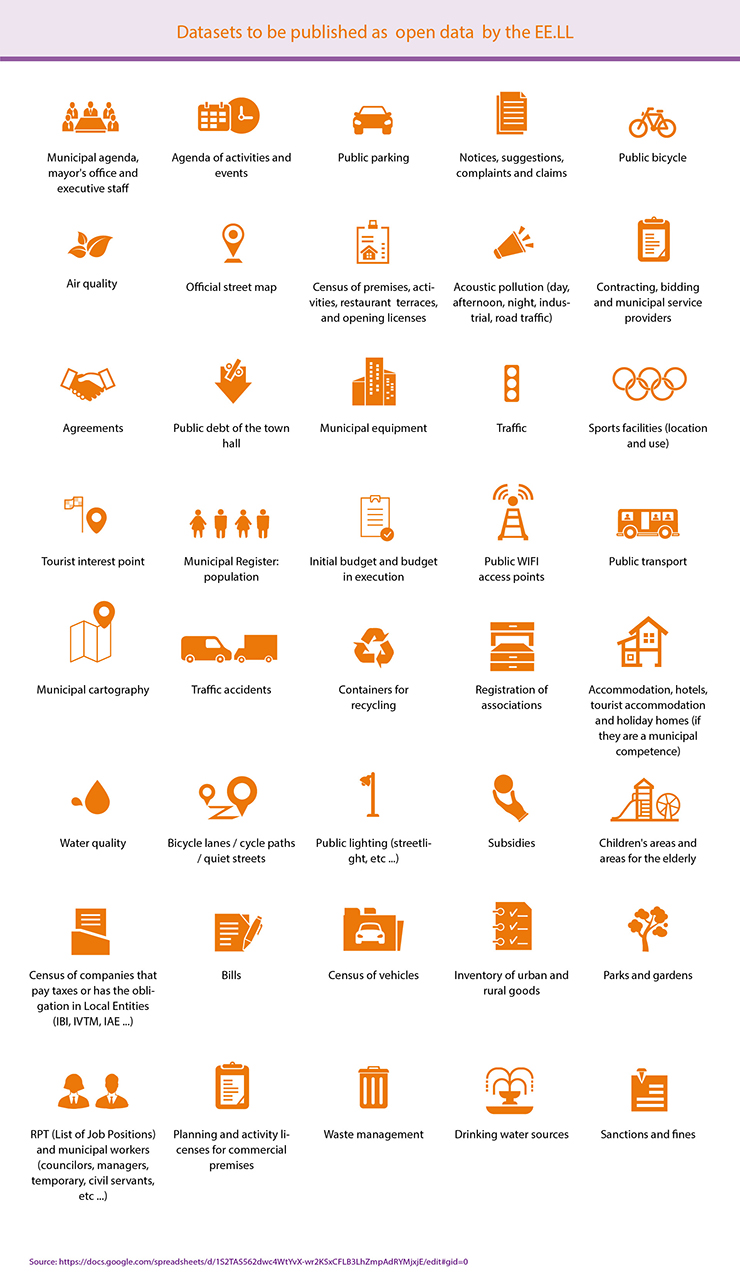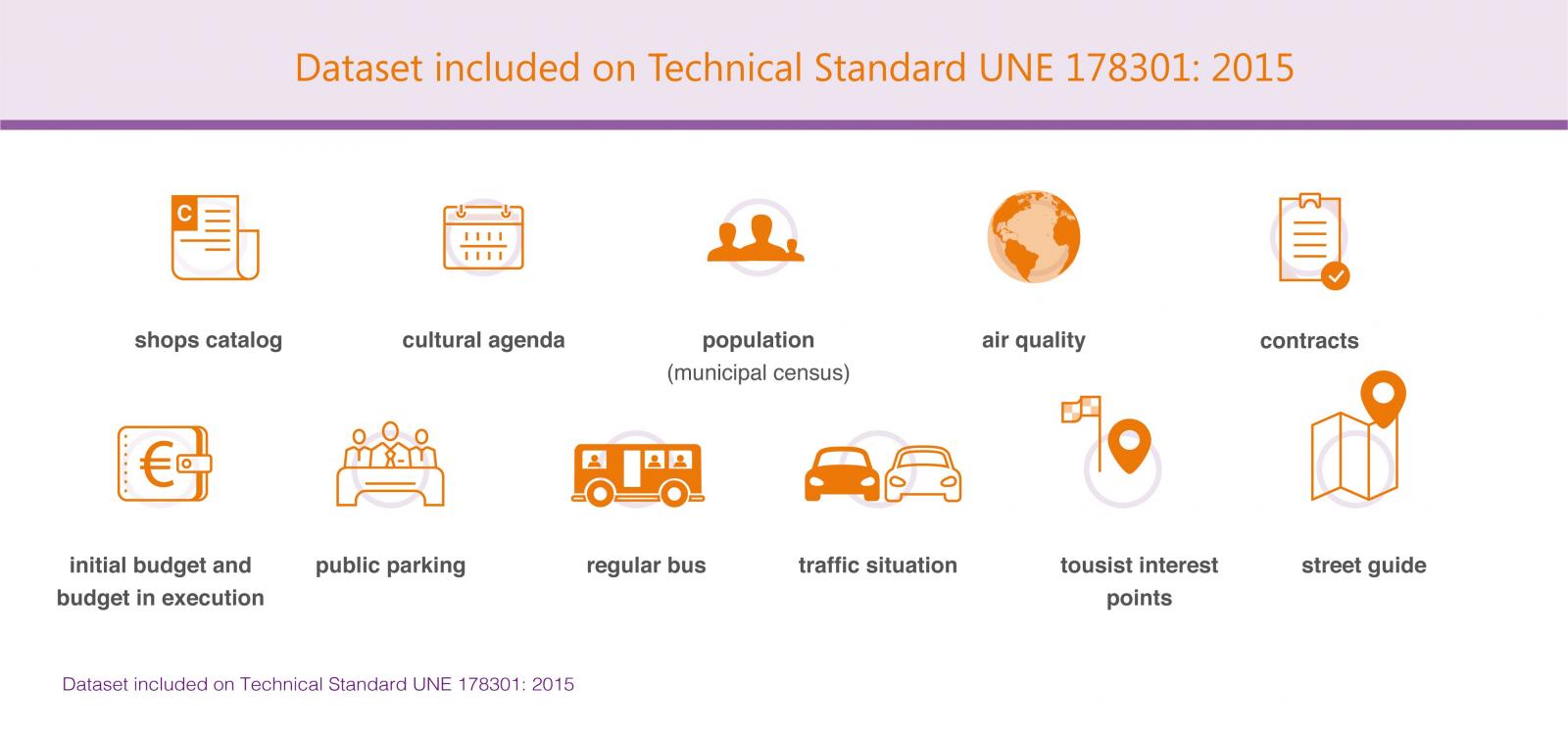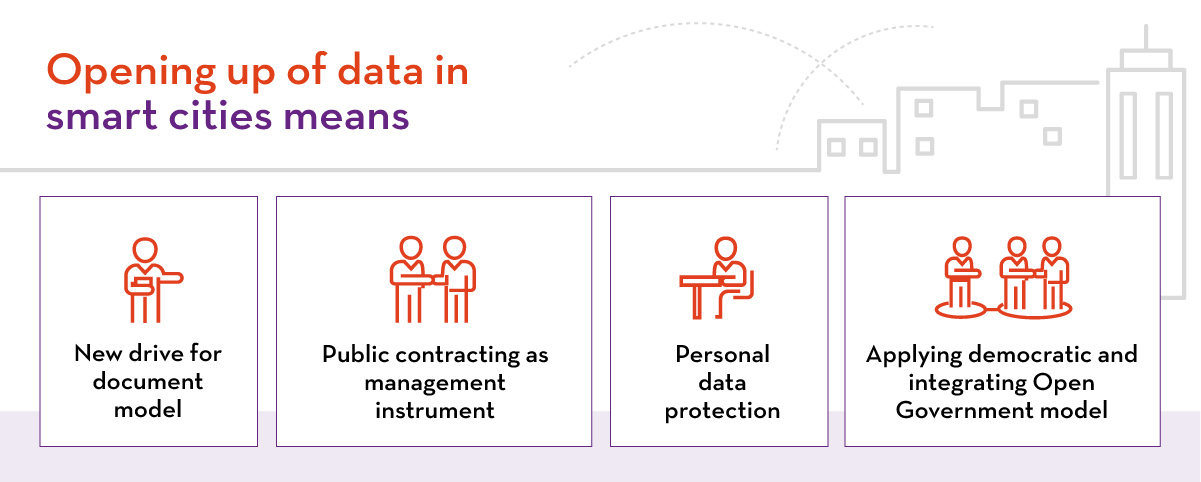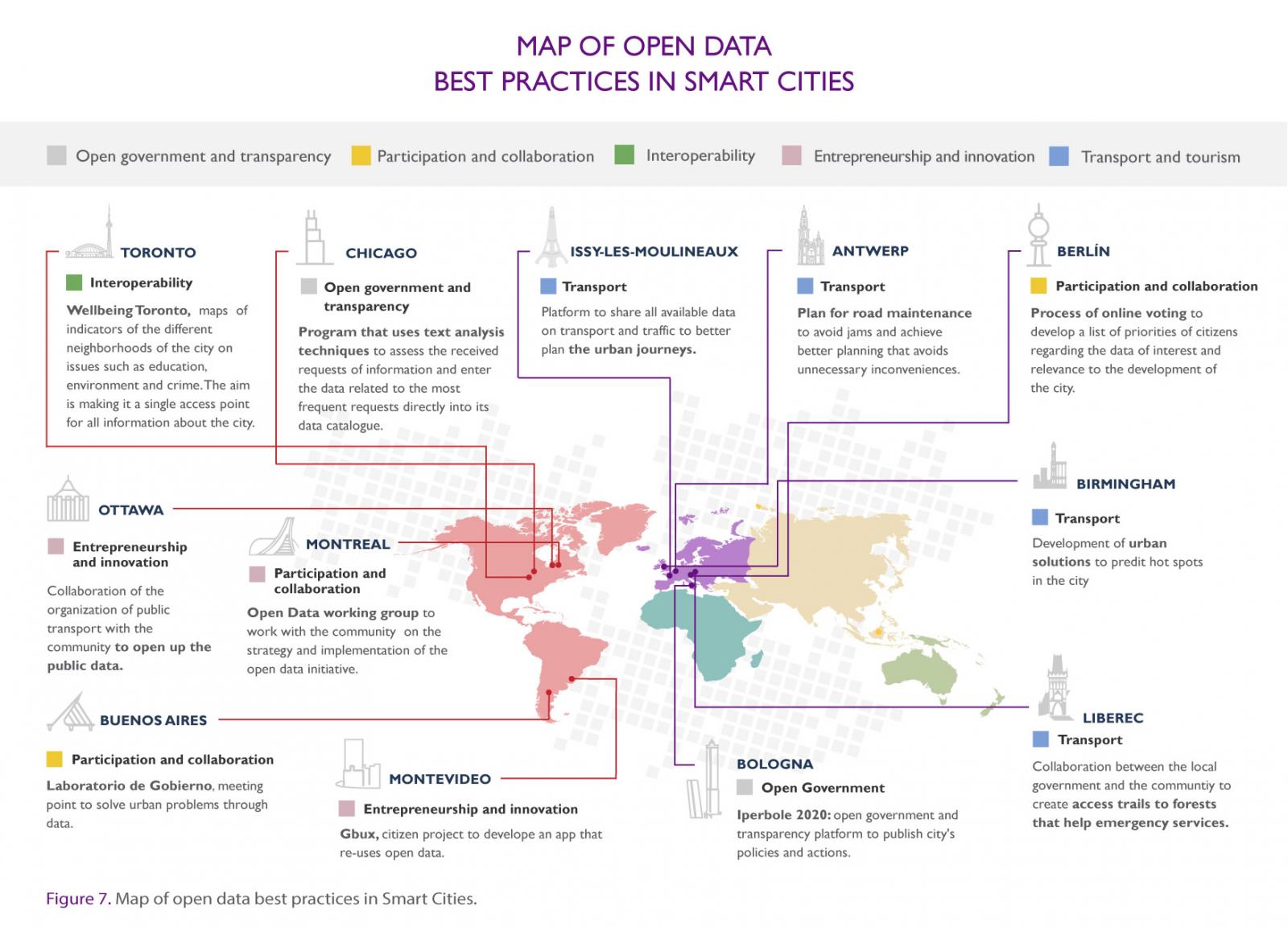In 2017, the Spanish Federation of Municipalities and Provinces (FEMP) published the guide "Open data: strategic guide for its implementation and minimum datasets to be published", which included a series of recommendations and guidelines for public data opening with the aim of driving its publication and reuse. In addition to information related to legal framework or governance model, the guide also included 20 datasets considered as "the most interesting, possible and easier to publish by public administrations".
After the guide success, the FEMP has continued working on expanding these datasets, identifying 20 new ones that will make possible to standardize the publication of open data and facilitate its management. For this, the FEMP count on the help of a multidisciplinary working group where different interest groups were represented: cities, citizens, companies, universities and public bodies.
The result is a new document, entitled Open Data FEMP 2019: 40 datsets to be published by the Local Entities, whose objective is to provide a "common open data model that facilitates interoperability and the reuse of public sector information", as well as to bring Spanish local entities’ commitment to normalize open data closer to the international community.
This new guide addresses not only what datasets should be published by local entities, but also how they should be published to make them more useful for citizens and reusers. Using different tabs - one for each recommended dataset – the report indicated the recommended format or update frequency when publishing each dataset. The guide also indicates each dataset reuse value or complexity (based on a scale from 1 to 5), as well as some recommended visualization to make easier citizens access to information.
The document is mainly oriented to medium to large cities, although smaller municipalities can also use it as a knowledge framework. It can help companies, citizens, universities, entrepreneurs, researchers, data journalists, students, etc. interested in the subject, although, the roles that can make the most of the information are:
- Those responsible for developing or that have to develop open data policies.
- Those responsible for Open Government policies (transparency, participation, accountability, collaboration).
- Those responsible for the development of Information Technology.
- Those responsible for "Smart Cities" and Innovation projects.
The following image shows which are the 40 datasets recommended in the document:

Here you can download the full report (in Spanish, with an executive summary in English):
The Global Open Data for Agriculture and Nutrition Initiative, known by the acronym GODAN, aims to support "the proactive sharing of open data to make information about agriculture and nutrition available, accessible and usable." To this end, GODAN fosters dialogue and cooperation in agricultural activities between more than 760 members, including governments, private companies, international organizations or NGOs.
Through different working groups, GODAN contributes to share ideas and experiences to solve key problems and challenges in the agriculture and nutrition sectors, using open data. Some of these challenges are ridding the world of famine, ensuring food security, improving nutrition or facilitating sustainable agriculture.
In order to help more companies, organizations and citizens to be aware of the importance of open data to solve these challenges, GODAN promotes the creation and dissemination of resources that drive both providers and users reflection on agricultural open data. Among these documents, we can find:
- Reports, which analyze different challenges and include recommendations or good practices aimed at enriching the available information about agriculture and nutrition, encouraging their analysis and reuse.
- Success stories, which can be used as an example for those organizations interested in being part of this ecosystem, but do not know how to take advantage of open data to generate new initiatives that add value to the sector and solve the aforementioned challenges.
- Courses aimed at strengthening data producers and consumers capacity to manage and use open data in agriculture and nutrition sector.
We have compiled some of these resources, described in the following table:
| Document type | Title | Content |
|---|---|---|
|
Reports |
Ownership of Open Data: Governance Options for Agriculture and Nutrition |
Moving to a model where data is open as a standard requires a change in legal, social and technological context, and this will have an impact on data ownership. To achieve this goal, the report analyzes the underlying rights and possible governance systems, such as the inter-organizational statute of open data, laws and policies, social certification schemes, etc. |
| A Global Data Ecosystem for Agriculture and Food | This study tackles open data sourcing and handling cycle, from the point of view of both users and providers, analyzing the challenges to be solved and the roadmap to build an ecosystem for global agricultural data. Among the proposals included in the report, we can find the provision of incentives and the promotion of trust between providers and users. To achieve this goal, a cultural and technological change will be necessary, as well as improvements in data quality, origin and access. | |
| Responsible Data in Agriculture | The report explores how inequalities between large agricultural corporations and small local producers could be reduced, to guarantee fair access to information. With this objective, they spoke to 14 individuals with different perspectives to understand their main challenges. The report concludes with a series of good practices, which include education and awareness actions, policies reviews or the prioritization of contextual considerations. |
|
| Success Stories | GODAN Success Stories - Issue 1 |
This report, published in 2016, explains different examples of open data projects and initiatives linked to agriculture and nutrition field. Through different stories, we can learn how to extract value from satellite images or how to improve land registration transparency, among other issues. |
| GODAN Success Stories - Issue 2 | The second part of the report was published one year later, with new success stories. In this case, we can find examples as FOODIE, a European initiative that seeks to solve agriculture challenges thank to geospatial data, or BOER & BUNDER, a web application that uses algorithms to extract data value, using simple visualizations to show the results. | |
| Curses | Open Data Management in Agriculture and Nutrition | Free online course with different calls throughout the year. Its objective is to promote agricultural and nutritional knowledge networks in different institutions, raise awareness of different types of data formats, explain possible use cases and highlight important it is for data to be reliable, accessible and transparent. |
To learn more about GODAN resources, you can visit their website publications section. In this section, which is periodically updated with new publications, users will find more documents and reports related to open data in agriculture. The dissemination of these contents can help develop high-level policies, and support the private sector for opening more data, which is fundamental to overcome important challenges for humanity.
As a result of transparency and citizen participation demand, an increasing number of towns are focus on initiatives that facilitate citizen access to institutions and administrations´ information. However, defining, implementing and documenting an open data policy could be a challenging issue. Some of the most frequently asked questions by agents involved in these initiatives are:
-
Which data are more strategic and which fundamental aspect should be consider at publishing?
-
How could I facilitate datasets integration from different sources?
-
What is the regulatory framework?
In this context, AENOR elaborated the Technical Standard UNE 178301: 2015. It provides a series of recommendations to standardize open data publication and improve data management. This Technical Standard includes a list of 11 datasets considered a priority by AENOR: shops catalog, cultural agenda, population (municipal census), air quality, contracts, initial budget and budget in execution, public parking, regular bus, traffic situation, tourist interest points and street guide.

In addition, Technical Standard UNE 178301: 2015 includes recommended vocabulary to optimize data publication, framed within Linked Data paradigm (a set of best practices, articulated through W3C standard technologies). The objective is to facilitate the development of a data website where different elements can be linked, simplifying navigation and data location, within a common international framework.
The report "Open data representation vocabulary in Digital Cities" provides an analysis of this Technical Standard. It include the description of each dataset, potential use cases and legislative framework- when applicable–, and common publication formats. In addition, the report includes an assessment of AENOR´s semantic proposal adequacy and development degree.
The commitment to so-called smart cities is currently one of the major commitments to technological innovation in the public sector, especially in the local sphere. This type of initiative aims to address challenges to sustainability in the urban context and, through the advanced use of information and communication technologies, to optimise resources and make public services more efficient.
The report ‘Open Data and Smart Cities: an alternative legal perspective’ that we published on Datos.gob.es approaches the scope and legal analysis of data openness in this type of project. It is particularly important to provide legal security for the investments and efforts being made by both local governments and service providers and, in general, for the involvement of civil society in this field. As analysed in this report, the plurality of actors and services involved determines the diversity of legal standards in a context where information and communication technologies require interoperability.

Structured into five chapters, the report deals with Law as a tool to serve smart cities, the diversity of actors as a subjective element, the plurality of services involved in a technological context as an objective element, and the scope of the regulatory framework applicable to intelligent cities from the perspective of open data. This last section details the regulations on electronic Government, the legal provisions on transparency and access to public sector information, the legal provisions on the re-use of public sector information, and the legislation covering the protection of personal data.
In the fifth and final chapter, which focuses on the prominence of legal means, the report raises the need for paradigm shifts to drive open data in smart city projects. In particular, it advocates the promotion of a management model based on the foundation of Open Government at the municipal government level, using its legal powers and means. It also proposes a series of prerequisites required to allow the opening of data in smart cities in order to facilitate the re-use of the data generated.
In conclusion, the report ‘Open Data and Smart Cities: an alternative legal perspective’ refers to the need to be aware of the fragmentation of the existing regulatory framework and the challenge for local governments when making reasonable modifications to their own regulations and supporting effective leadership in order to offer value-added services based on their re-use according to the principles of open data.
The attached Report can be downloaded in PDF, Word, and ODT format.
Together with the Report on the Infomediary Sector Characterization 2016, the National Observatory of Telecommunications and the Public Information Society has published a report on success stories and best practices in the re-use of public information, based on the selection and subsequent study of eleven national companies.
In the elaboration of this document, all the companies belonging to the Spanish infomediary sector were taken into account, selecting and interviewing those ones that fulfilled in the most optimal way with the criteria of innovation, effectiveness, sustainability and replicability.
Through the qualitative analysis of their activities, the report draws conclusions that characterize the infomediary sector in Spain and also includes where the most relevant information related to the added value services and products based on the re-use of public information is shown.
The National Observatory of Telecommunications and the Information Society (ONTSI) publishes annually the report on the infomediary sector characterization which analyzes in detail the activities and influence of industry in the national socioeconomic sphere.
The fourth edition of this report collects data from 535 infomediary companies during 2015, all of them specialized in the development of products and services based on the re-use of public and/or private information. The necessary data for the elaboration of this study was collected through surveys to the different companies of the sector.
In this edition, as a novelty compared to previous years, the characterization study is accompanied by a document which lists eleven successful cases of infomediary companies in Spain. Thanks to both studies, it is possible to have a detailed image of the Spanish infomediary sector which encompasses both the volume of business, the jobs generated at national level, the origin of the re-used information, as well as the barriers and opportunities detected by the companies interviewed.
Cities are increasingly gaining population. While large cities only occupy around 2% of the planet's land mass, nowadays half of humanity lives in cities, 70% of the population in Europe, and it is expected that by the year 2030, almost 60% of the world population will live in urban areas consuming approximately 80% of the planet's resources.
Demographic growth will be a major challenge in the sustainable and efficient management of cities.Transport, education, health care, waste management ... are just some of the areas that will be affected and may become an obstacle on the way to the Smart Cities. In this global context, data is an essential resource and its openness and reuse are key aspects to understand what is happening in cities and make the right decisions to ensure the optimal management of Smart Cities.
Aware of the potential of Open Data, Iniciativa Aporta has published a new version of its report "Open Data, as a tool for Smart Cities". A document that addresses both the strategic aspects of Open Data for a local administration and the necessary components for the success of an initiative of this nature, all exemplified by real cases of different cities in the world. In this way, the reader can locate in the globe the most significant international initiatives that re-use information of the public sector to improve the quality of life of citizens.

In order to improve and update this material, the content has been enriched with graphic elements that help its comprehension and dissemination. In addition, a map has been included where the world's most relevant Open Data and Smart Cities projects are located according to five priority themes: transport, tourism, open government, interoperability and entrepreneurship.
All the materials created to date are available in the Documentation section of the new portal datos.gob.es, where not only the documents are published but the user has also the opportunity to find resources from other organisms, all related to the re-use of public sector information.
Law 18/2015, of 9 July, amending Law 37/2007, of 16 November, on re-use of public sector information, provides that the authorities and public bodies have a clear obligation to authorize the re-use of their information, including those institutions in the cultural field such as museums, archives and libraries.
In order that the provision of information for its re-use does not interfere with the privacy of personal data, the Spanish Data Protection Agency has published a Guidance document on data protection in the re-use of public sector information which gathers all aspects to be considered by the public sector to release data ensuring the fundamental right to data protection recognized in Article 18.4 of the Constitution, in the Article 4.6 of Law 15/1999 on Protection of Personal Data and in the Article 8 of the Charter of Fundamental Rights of the European Union.
As laid out in the document, the treatment and re-use of public sector information by the re-user may involve the combination of that information with other data sources, using technologies of big data or data mining that limit the monitoring and control over the use of public open data and, therefore, could cause uncertainty about the privacy of such information. Nevertheless, according to the AEPD, these associated risks should not lead to a restriction of re-use considering its advantages to the whole society. The guide attempts to answer this question, highlighting the importance of preventive methodologies such as the assessment of re-use impact in the protection of personal data -which analyzes the potential risks that the treatment of the personal data may involve- and proactive solutions such as the anonymization of data, as well as the legal guarantees and tools needed thereof.
The document shows how to evaluate the impact on data protection by the body that authorizes the re-use of the information, which can develop the analysis independently or with the help of the re-user, without providing, in such case, sensitive or personal data.
In addition, the text indicates how anonymization can be strengthened through legally binding commitments such as the express indication to prohibit the re-identification and use of personal data in decision-making. Finally, it also includes some example measurements to ensure the compliance with these legal guarantees: from periodic assessments of the re-identification risks; audits on the use of reused information or the inclusion of warnings on the re-identification of personal data on websites.
Thanks to this guidance, the Spanish Data Protection Agency opens the way to spread good practices in finding the answer to one of the main risks associated with the re-use of public sector information such as the re-identification of citizens, instructing managers of public institutions in how to facilitate open data in compliance with the legal guarantees of data protection.